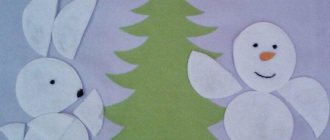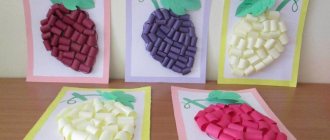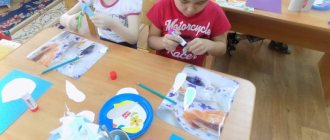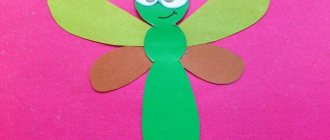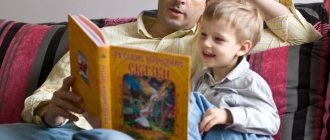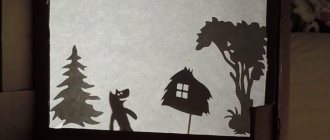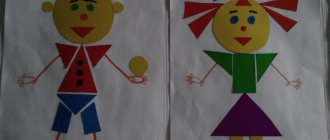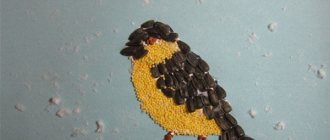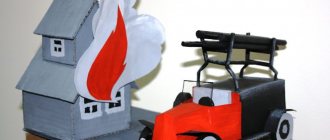A colorful geometric paper applique is the most affordable way to instill in your child a lot of useful skills.
Working with scissors, glue and paper, children learn to be neat and persevering, and gain joy from the process of creative activity.
Using simple geometric shapes makes it easy for even young children to create impressive pictures.
Preparation
The first step is to prepare for the development process:
- When organizing a workplace, everything unnecessary is removed from the table.
- You can cover the surface with oilcloth to protect it from glue.
- All elements are cut out in the required quantity.
- It is recommended to use stationery scissors with blunt tips - they are comfortable for the child and he will not be able to cut himself with them.
- A background base is selected from colored paper or thick cardboard.
- For younger children, it will be more convenient to use pencil glue rather than PVA.
- To make the activity more interesting, you should choose beautiful and bright colors.
Before creating an application, you need to tell your child about geometric shapes - show the blanks, name their shapes. It is important to become familiar with the sequence.
Your child will be interested in creative activities together, and teamwork will strengthen relationships. Over time, the baby himself will learn to assemble compositions from different elements.
What appliqué classes do for a child
Any handmade crafts bring great benefits to children. This statement fully applies to geometric applications. With their help, children:
- become more patient, diligent, careful;
- get acquainted with geometric figures;
- learn the names of objects, animals, birds, insects, vehicles, and other objects;
- develop fine motor skills, creativity, intelligence;
- receive the basics of design and labor discipline;
- learn to work with tools and different materials (scissors, brush, glue).
Applique classes really make children more collected, neat, and disciplined. But it’s impossible to keep kids’ attention for a long time, so when choosing tasks, you need to start with the simplest crafts, the production of which will not take much time.
Children do their first crafts together with their parents, older brothers and sisters, friends, and teachers. This instills in them the first skills of collective work and teaches them to work in a team.
For the little ones
Toddlers are just beginning to learn about crafts and shapes. Initially, you should randomly distribute the shapes on the sheet so that the child learns to work with glue.
Children aged 1-2 years are characterized by energy and restlessness, so you should start the lesson in a playful way.
You can tell a story about a circus bear who lost his juggling balls. The child will get acquainted with different colors, the circle shape and learn how to handle glue.
For the applique you will need three circles of different diameters made of colored paper. You can print the bear using a template or use a sticker. The bear is glued to the background sheet, and the child’s task is to find balls of a certain color. The found circle is covered with glue.
It is important to teach your child to hold the glue at a 90 degree angle. The part is located in an arbitrary location.
When the baby learns to handle glue, you can complicate the task a little and try to make an applique along the contours. To do this, geometric shapes are sketched on a sheet or cardboard, and parts corresponding to the drawing are cut out of colored paper.
The baby must find and glue the parts along the contours of the picture.
Outline of lessons on applique, modeling (senior group)
- GBOU School No. 967
- Structural unit No. 3
- Topic: “Our farm” - applique of geometric shapes of different sizes
- Spent:
- Teacher gr. 2
Yumanova V.A.
- Moscow
- 2019
- Tasks:
- — Teach children to create images of different pets based on two ovals, adding various details.
- — Strengthen the ability to cut out ovals from rectangles folded in half, rounding the corners.
- — Teach children to convey spatial representations (near, side, right, left, closer, further).
Preliminary work. Looking at pictures of domestic animals and their babies. Designing images of animals from geometric mosaics. Reading fiction. Conversation on the content of the painting “The Farm”.
- Preparing the basis for a future composition: for children's work, the teacher cuts out green lawns and blue puddles (in the form of blots) from colored paper and prepares the basis for a collective composition - a large sheet of paper.
- Materials and equipment: paper rectangles (different in size and color), scissors, glue, glue brushes, glue sticks, cloth napkins, oilcloths, boxes for scraps, felt-tip pens for decorating small parts.
- Progress of the lesson
- The teacher shows the children the picture “Farm”.
- Educator: - Who lives on the farm?
- A finger game is played, depicting domestic animals.
- Dog
- The dog has a sharp nose
- There is a neck and a tail.
(Right palm on the edge, towards you. Thumb up. Index, middle and ring fingers together. The little finger alternately lowers and rises).
- horse
- The horse's mane curls,
- Playfully beats with its hooves.
(The right palm is on the edge away from you. The thumb is up. The left palm is placed on top of it at an angle, forming a mane with the fingers. The thumb is up. Two thumbs form the ears).
- Cat
- And the cat has ears
- Ears on the top of the head
- To hear better
- The mouse is in her hole.
(The middle and ring fingers rest against the thumb. The index and little fingers are raised up).
The teacher attaches ovals to the flannelgraph: three large ones and above them, at a short distance on the side, a slightly smaller one.
Educator: - Guys, who or what can these ovals be turned into? (Children's answers).
Educator: - And now I invite you to see how these ovals turn into different animals. Guys, look at the figures of three animals (dog, sheep, horse), which are based on ovals - a large one (torso) and a small one (head).
- Educator: - I will show you pictures, and you must say who it is and how you guessed about it.
- All these animals are similar in that they have a large oval body and a small oval head; But animals differ in other parts of the body - tails, necks, legs.
- Educator: - I will leave the pictures on the board so that while you work you can compare your ideas about animals with them.
- Educator: - Children, tell me how to cut out ovals.
(Children's answers: you need to fold the paper rectangle in half, and holding the fold, round the corners, first one, then the other. When we unfold it, we will get an oval.)
Educator: - I remind you of the safety rules when working with scissors.
I hold a large oval in one hand and a small one in the other, and begin to show you combinations of torso and head placement.
Educator: - Who could it be if the head is attached directly to the side of the body? right or left? (Sheep, pig).
— What kind of pet can you get if you raise your head above your body from the side? (Horse, cow).
— If you lower your head below your body? (Any animal that eats or drinks).
Educator: - Guys, think about what animal you would like to depict from ovals. (Children choose paper that is suitable in color and size and begin to cut out, checking the drawings or images of animals in the painting “Farm”).
Next, children place (stick) animal figures on the lawns, in blue puddles pre-cut by the teacher, and place them on the general composition “Our Farm”, complement the picture by drawing animals and other farm paraphernalia.
Source: https://nsportal.ru/detskiy-sad/applikatsiya-lepka/2019/03/26/nasha-ferma-applikatsiya-iz-geometricheskih-figur-raznoy
House
Photos of applications for the little ones clearly show how you can assemble a picture from simple shapes. To make a house you will need a template or sketch, glue, scissors, colored paper and cardboard.
From colored paper, cut out a large square and a triangle for the house, a small square for the window, and use a rectangle for the door.
All parts are sequentially treated with glue and placed on the base.
Balloon flight
In this application, in addition to colored paper, you will need threads. The manufacturing process is as follows:
- Multi-colored circles and ovals of different diameters are cut.
- Separately, threads of colors corresponding to the blanks are glued onto a cardboard, paper or plywood base. The base is painted the color of the sky.
- Children must match the circles to the threads by color and stick them on.
- The result is balloons with strings flying across the sky in random order.
You can add clouds to the picture (draw them or make them out of cotton wool) and the sun.
Typewriter
When working with a child, it is important to take into account his interests; for example, a boy will be much more interested in assembling a craft in the form of a car. The application will be appreciated by children aged 3-5 years, and for the work you will need colored paper, glue, a simple pencil, scissors and a model of the machine.
Stages of work:
- Shapes are cut out - rectangles for the body, circles for the wheels. You can complement the picture with smoke from ovals, and a route from a black elongated rectangle. Details are added or removed based on the child’s characteristics; if the baby is diligent and easily involved in the task, then you can freely supplement the composition. Don’t forget about the brightness of color, it is what makes the creative process even more interesting.
- Each element is smeared with glue in turn and glued to the background. The road and body come first, and then the wheels and smoke.
For greater expressiveness, you can draw trees, the sun and clouds with colored pencils. Blue color is ideal for a base. In a more complex version, the child himself cuts out the parts along the marked lines.
Space
1st grade boys often dream of becoming astronauts. They will be happy to make an application on a space theme:
- The outline of the rocket is applied to the base.
- For planets and rocket portholes, several circles are cut out (from 7 to 10).
- For stars, smaller circles are made (10-15).
- The triangle is needed for the nose of the rocket.
- Another triangle, cut in two, plays the role of the rocket's tail.
- From a large rectangle, many strips are made and pasted to resemble the fire released by the rocket.
The missing elements of the application can be completed.
For children from 3 years old
At the age of three, children can already assemble a picture of 6 parts in the correct sequence. You can choose animals for applique that are familiar to the child - for example, a hen with chicks.
For production you will need:
- Green cardboard.
- Yellow circles - 3 pcs.
- White circles of different diameters - 2 pcs.
- Triangles – 1 white, 2 yellow, 3 red, 6 brown.
- Colored markers.
- Glue.
The first step is to prepare a sample, and the children follow the picture and lay out their applique. It is advisable to focus on the baby’s characteristics; for some it is easier to create from a sample, while others prefer to repeat the actions step by step.
Eyes are added to the pasted chickens. The picture can also be supplemented with green grass made from stripes, a bright round sun, and daisies made from white triangles.
For the little ones there is a large selection of colorful applications for creativity, with self-adhesive figures. The kits are sold in bookstores or delivered via courier.
Ready-made sets help develop fine motor skills.
Vase with candies
The word “vase” in this task is conditional. The child can fill a jar, plate, tray or glass with colorful shapes. It is these objects (their outlines on paper, cardboard) that will act as the basis. The step-by-step process of making a craft looks like this:
- You need to prepare a base with the outline of a basic object applied to it - vases, jars, plates.
- Cut out circles of different diameters from multi-colored paper or foil that will symbolize lollipops.
- Kids must fill the outline of the base object with candies in any order, without going beyond its boundaries.
- You can complement the applique with painted flowers, candies of other sizes, and the sun.
School age children
Junior grades are able to independently separate details according to a model, and can assemble a complete picture, focusing on their imagination. Initially, you should show the children what the finished craft will look like.
To work you will need brushes, colored paper, glue, scissors, cardboard, a ruler and a simple pencil.
A base is prepared, geometric shapes in a specific theme are sketched on it. All details are copied from the base, cut out and glued according to the template.
Applications for primary schoolchildren
The theme of applications from geometric shapes for schoolchildren is animals and birds, insects and natural objects. Teachers can simplify any task by showing ready-made samples of work and handing out prepared stencils (templates).
Depending on the child’s age, they are asked to assemble a picture from ready-made circles and squares or cut them out themselves.
Further, the task can be complicated - lay out the fragments symmetrically or change the shape, but so that the image becomes recognizable.
We offer a gallery of the best works of preschoolers and applications made from geometric shapes by children in grades 1-2.
Photo of geometric applique
At what age can you start teaching geometric shapes to your child?
According to scientists, a child should be taught from birth, and it is carried out in several stages:
- After birth, the baby remembers almost nothing, but learns to look at the world in all its aspects. At this time, it is recommended to talk to the baby, pronouncing each figure, read short children's poems, and sing songs.
- When the baby turns 6 months old, he will try to learn more about the world. To do this, he will touch and bite objects. It is important to choose the right toys. A set of soft squares with flowers, butterflies, and birds painted on them will do.
- The next stage begins when the baby learns to speak. It is necessary to pronounce all the names of the shapes, starting with the simplest ones (circle, triangle, square). Then comes the turn of the trapezoid, rectangle and others. A toy pyramid, plastic cubes used to build a tower, and drawing will help at this stage.
Studying geometric shapes with a child can begin from a very early age.
Thus, learning can be done from the birth of a child, using different techniques.
During the classes
II. Setting the goals and objectives of the lesson.
We often say: “Learn creativity, develop independence, design abilities, artistic taste...” What type of work activity will help us with this? (Working with paper). And more specifically? (Applique).
III. Conversation.
What is an application? Applique is a decorative work consisting of making various images (patterns, ornaments, drawings, paintings) by cutting and attaching them to the surface of paper, fabric, leather, wood or plastic. What are the differences between applications? A variety of shapes, materials, colors and textures of parts made from one or another specially selected sheet materials: colored paper, fabric, leather, dried plants, straw, birch bark.
Where is the application used? In clothing, in arts and crafts, on covers, bookmarks, cards and household items. For a long time, people have strived to make their homes, clothes, and household items not only comfortable, durable, but also beautiful.
IV. The main part of the lesson.
Pay attention to the works presented on the demonstration board and say: what application will we make today? (Applique using geometric shapes)
Name the geometric shapes used in the work. (Square, triangle, circle, oval, arc, rectangle). Adult design artists most often show their design ideas in drawings and technical drawings, but we can also show this work in appliqué.
What are the stages of construction and where do you start? They invent it, draw it, create it. These steps are also used in the application.
Before starting the main work, let's practice. Let's split into two teams and have a competition. Each team was given a Lego panel and a technical map. The technical card shows "Clown". What needs to be done: quickly, efficiently and quietly complete the structure. Each player must place two figures on the canvas (the figures are arranged according to the geometric shapes depicted on the tables).
Conducting a competition. Summing up the competition.
V. Practical work.
So, we move on to practical work. Name the tools used when working with paper. (Scissors, glue brush, pencil).
Let's repeat the safety precautions when working with scissors.
VI. Planning practical work.
Take the technical card and look at it. Where to start with the application?
- Definition of geometric shapes (a template punch card with images of geometric shapes is provided to help).
- Number of shapes and color.
- Execution of the application.
Think about how to quickly and economically use paper when cutting out this or that shape.
VII. Execution of the application.
Construction of a control line on which the application is built. Depending on the drawing, the line will be at the top or bottom. When starting work, do not forget that when summing up the results will be taken into account:
- Quality of work;
- Color solution;
- Location on the sheet.
